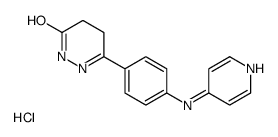Senazodan hydrochloride
Modify Date: 2025-08-27 20:48:42

Senazodan hydrochloride structure
|
Common Name | Senazodan hydrochloride | ||
|---|---|---|---|---|
| CAS Number | 98326-33-1 | Molecular Weight | 302.75900 | |
| Density | N/A | Boiling Point | 492.4ºC at 760 mmHg | |
| Molecular Formula | C15H15ClN4O | Melting Point | N/A | |
| MSDS | N/A | Flash Point | 251.6ºC | |
Use of Senazodan hydrochlorideSenazodan (MCI 154) (hydrochloride), as a Ca2+ sensitiser, shows inhibition effect on PDE III[1][2]. |
| Name | 6-[4-(4-Pyridinylamino)phenyl]-4,5-dihydro-3(2H)-pyridazinone hyd rochloride (1:1) |
|---|
| Description | Senazodan (MCI 154) (hydrochloride), as a Ca2+ sensitiser, shows inhibition effect on PDE III[1][2]. |
|---|---|
| Related Catalog | |
| Target |
PDE III[1] |
| In Vitro | Senazodan (hydrochloride) seems to affect directly the actin-myosin crossbridge kinetics, and increases myosin ATPase activity[1]. Senazodan (hydrochloride) produces a concentration-dependent increase in tension development. Senazodan (hydrochloride) enhances Ca2+ binding to myofilaments and to purified cardiac troponin C. Senazodan (hydrochloride) also enhances contractility in guinea-pig papillary muscles by inhibiting PDE III[2].Senazodan (0.1 nM~0.1 mM) (hydrochloride) shows that the contractile response of superior mesenteric arterie (SMA) to norepinephrine (NE) after hemorrhagic shock is significantly decreased as compared with the normal control group. Senazodan (0.01 mM) (hydrochloride) pretreatment prevents the effects of Ang II, and the concentration-response curve of Ca2+ is shifted to the right as compared with Ang II-alone group[3]. |
| In Vivo | Senazodan (0.1~2.0 mg/kg; left femoral vein catheterization infusion) (hydrochloride) decreases the pressor effect of norepinephrine (NE)[3]. Senazodan (0.1 mg/kg; i.v.) (hydrochloride) makes LVSP, IP, MC, and Lo all increased significantly, while heart rate is not obviously changed and left ventricular end-diastolic pressure (LVEDP) is reduced remarkably[4]. Animal Model: Wistar rats (200~250 g)[3] Dosage: 0.1~2.0 mg/kg Administration: Left femoral vein catheterization infusion Result: Decreased the pressor effect of norepinephrine (NE). Animal Model: Rabbits[4] Dosage: 0.1 mg/kg Administration: I.v. Result: LVSP, IP, MC, and Lo all were increased significantly while heart rate was not obviously changed and left ventricular end-diastolic pressure (LVEDP) was reduced remarkably. |
| References |
| Boiling Point | 492.4ºC at 760 mmHg |
|---|---|
| Molecular Formula | C15H15ClN4O |
| Molecular Weight | 302.75900 |
| Flash Point | 251.6ºC |
| Exact Mass | 302.09300 |
| PSA | 73.10000 |
| LogP | 2.37470 |
| InChIKey | NYQCKFLLTCINSJ-UHFFFAOYSA-N |
| SMILES | Cl.O=C1CCC(c2ccc(Nc3ccncc3)cc2)=NN1 |